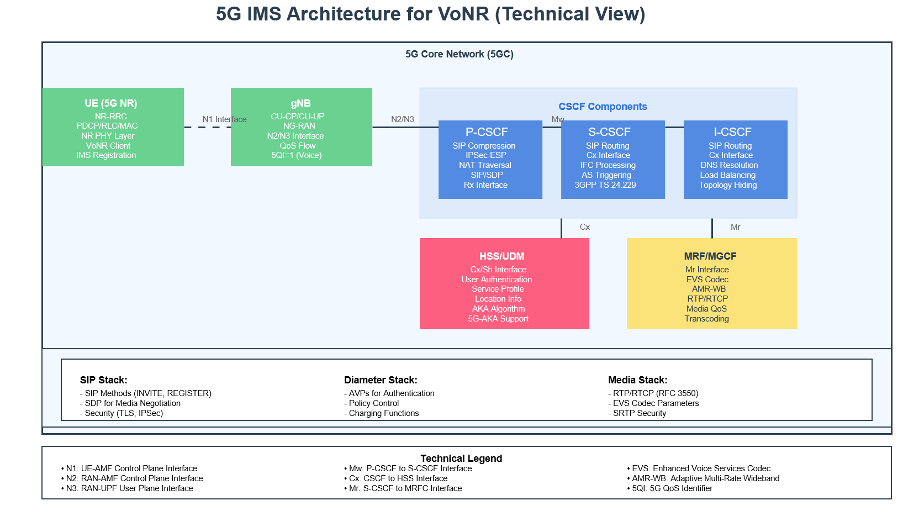Introduction
- Introduce the IP Multimedia Subsystem (IMS) as the core network element designed to provide IP-based multimedia services, particularly VoIP, across LTE and now 5G networks.
- Highlight the critical role of IMS in supporting the 3GPP standard Vo5G (Voice over 5G), ensuring high-reliability, low-latency voice communication, and integrating seamlessly into the 5G Service-Based Architecture (SBA).
- Overview of how IMS enables multi-service functionalities, expanding from traditional VoLTE to advanced multimedia in a 5G environment.
1. Core Components of IMS Architecture in 5G
- Call Session Control Function (CSCF):
- Proxy-CSCF (P-CSCF): Acts as the initial point of contact for the UE (User Equipment) and handles signaling between the UE and IMS.
- Serving-CSCF (S-CSCF): Central to call control; it maintains user session state and enforces policy.
- Interrogating-CSCF (I-CSCF): Responsible for routing incoming requests to the appropriate S-CSCF, particularly in roaming scenarios.
- Home Subscriber Server (HSS) / Unified Data Management (UDM):
- The HSS provides the user authentication data and profile information. In 5G, this role is evolving into the UDM, which leverages SBA to interact dynamically with IMS.
- Media Resource Function (MRF) and Media Gateway Control Function (MGCF):
- Handle media stream management and resource allocation, crucial for maintaining QoS during high-demand services like Vo5G.
- Protocol Stack: Discuss SIP’s signaling role, Diameter for policy and charging control, and RTP/RTCP for real-time media delivery.

2. IMS-5G Core Network Integration
- Service-Based Architecture (SBA) Integration:
- IMS in 5G operates in conjunction with the SBA, which allows service components (e.g., AMF, SMF) to interact as modular services, facilitating rapid deployment and scalable communication across network slices.
- Service-Based Architecture (SBA) Integration:
- IMS and Network Function Virtualization (NFV):
- NFV allows IMS functions to run as virtualized network functions (VNFs), enabling dynamic resource allocation and resiliency. This adaptation is critical as 5G requires high availability and scalability for IMS functions to meet real-time communication demands.
- Control and User Plane Separation (CUPS):
- IMS in 5G leverages CUPS for efficient handling of signaling and media traffic, essential in optimizing user-plane resource management, especially for latency-sensitive services.

3. Role of IMS in Voice over 5G (Vo5G)
- Quality of Service (QoS) and Policy Control:
- IMS relies on QoS policies to maintain priority for voice services in 5G, managing bandwidth dynamically based on network conditions.
- Policy Control Function (PCF): Manages policy enforcement across the 5G core to ensure reliable service quality, critical for Vo5G.
- Packet-Switched Voice Capabilities:
- Vo5G operates over the packet-switched domain with IMS at its core, enabling seamless IP-based voice services without relying on traditional circuit-switched fallback (CSFB).
- Vo5G Handover Mechanisms:
- IMS-based Vo5G supports advanced handover mechanisms between 4G LTE and 5G NR, addressing challenges in maintaining call continuity and avoiding call drops during network transitions.
4. Technical Challenges of IMS in 5G Networks
- Interoperability with Legacy Systems:
- Integrating 5G IMS with existing VoLTE/IMS systems poses compatibility challenges, particularly with older RAN equipment and protocols.
- Latency Constraints and Network Congestion:
- IMS architecture in 5G needs to meet stringent latency requirements for Vo5G; leveraging edge computing and optimizing routing paths become critical.
- Network Resource Management in High-Demand Scenarios:
- IMS must dynamically manage resources for real-time services; challenges include adapting to the varying bandwidth demands of multimedia applications and maintaining QoS in dense user environments.
5. Security and Authentication Challenges in IMS
- Secure SIP Signaling:
- IMS signaling, primarily over SIP, faces security vulnerabilities like SIP hijacking and spoofing. Encryption protocols (e.g., IPsec, TLS) are implemented to mitigate these risks.
- Identity and Data Protection:
- Protecting user data and identity within IMS, especially as it integrates with the 5G core, requires robust identity verification (e.g., using SUPI in 5G).
- Enhanced Authentication and Authorization:
- The Unified Data Management (UDM) in 5G provides centralized authentication, ensuring security across multiple services, including Vo5G and video calling.
6. IMS Optimization for 5G: New Technologies and Approaches
- Edge Computing Integration:
- IMS services are increasingly offloaded to Multi-Access Edge Computing (MEC) platforms, reducing latency by placing IMS functions closer to users.
- Network Slicing for Vo5G:
- 5G slicing allows IMS to operate within dedicated slices, enabling optimized QoS and SLA adherence for real-time applications.
- Cloud-Native IMS:
- Moving IMS to a cloud-native framework enhances scalability, allowing network operators to manage workloads more efficiently and support advanced services on-demand.
7. Future Outlook of IMS in 5G and Beyond
- Transitioning Towards 6G:
- IMS is expected to evolve toward more distributed architectures, embracing AI-driven network management and edge-focused architectures to handle the demands of 6G.
- Advanced Multimedia Support:
- The development of IMS beyond voice services to support AR/VR, ultra-high-definition video, and mixed-reality applications, enabled by 5G’s high bandwidth and low latency capabilities.
Conclusion
- Summarize the central role of IMS within 5G networks, emphasizing the need for flexible, secure, and scalable architectures to meet evolving demands.
- Highlight how IMS, despite legacy challenges, continues to be crucial for high-quality, reliable communication in 5G, with ongoing advancements in network function virtualization, cloud-native design, and security.
- Brief outlook on the innovations in IMS as networks continue their evolution toward 6G, supporting new, immersive multimedia services that will reshape user experiences in mobile communication.
You Might Also Like

14
Nov




